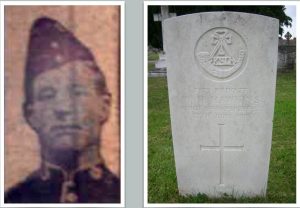1st Battalion, King’s Shropshire Light Infantry

William Henry Hawkins was born at Shifnal, Shropshire on 15 November 1883. He was the son of Robert Hawkins (1863-1939), an iron worker and his wife Phoebe (nee Wilkes: 1862-1918) and they had ten children.
The 1901 Census indicates that William was employed (aged 17) as a servant at a house in the Manchester suburb of Worsley. It is believed that he joined the Army in January 1903, unfortunately no records relating to this service have survived. It is possible that he signed up for either seven years ‘with the Colours’ and five in the Reserve, or the other way round. It is likely that this service was with the 1st Battalion, King’s Shropshire Light Infantry (KSLI).
A Public Member Tree on Ancestry included an extract from an unknown newspaper reporting his death, states ‘he had served a good time in the Army and on his discharge worked as a miner at Lilleshall Co’s, Woodhouse pit until the outbreak of war’.
The 1911 Census shows him living at 37 Old Park, Old Park, Dawley and his occupation as a colliery hewer’.
On 10 May 1908 he married Mary (Polly) Freeman (1884-1939) at Malinslee, near Telford, Shropshire. The couple had three children (Edith Evelyn born 1908); Rosannah Gertrude (1910) and Reuben Dennis (1914). The family continue to live at the above, Old Park, Dawley, address until William’s death.
It is almost certain that William was recalled from the Army Reserve at the outbreak of the Great War and would have re-joined the 1st Battalion, KSLI at Tipperary on 4 August 1914. On the 20th of that month the battalion moved to Cambridge and on 10 September landed at St Nazaire to join up with 16th Brigade, 6th Division of the British Expeditionary Force (BEF). At that time the Brigade CO was Brigadier General Edward Ingouville-Williams (nick named ‘Inky Bill’ by the troops). He was killed by a shell on 22 July 1916, during the Battle of the Somme, whilst a Major General, commanding 34 Division.
On 17 June 1915 the 1st KSLI took over front line trenches at Potijze in the Ypres Salient. This part of the British Line was subjected to regular shelling by the German artillery. The battalion War Diary records that during the period 18 to 22 June the battalion suffered casualties on a daily basis, as a result. From 17 June until the end of the month the Battalion lost 12 killed and 27 wounded, amongst other ranks. Private Williams was no doubt one of those wounded, most likely in the days spanning 18 to 22 June.
According to a recently released Pension Record Card he suffered a ‘lacerated scalp fracture of the cranium’. This would have been caused by shrapnel, at a time when British troops headgear was still the cloth service cap, which gave little or no protection: the steel ‘Brodie’ helmet did not come into regular issue until April 1916.
Following his wounding, William would have been passed down the casualty evacuation line and was re-patriated to England, arriving at the military hospital established at Cheltenham Racecourse, Prestbury on 24 June. According to reports in the Gloucestershire Echo, of 26 June and 1 July 1915 he was in the first party of wounded to be received by the hospital direct from the front.
Whilst at the hospital he barely regained consciousness and when he died, on 27 June 1915, aged 31 he became the death in the hospital, since it was established in the previous autumn.
Private William Henry Hawkins’ funeral, with military honours, took place on 1 July 1915, attended by his wife, father and sister, plus staff from the hospital.
He was buried in Cheltenham Cemetery, where a standard CWGC headstone marks his grave. He is commemorated on the Dawley Urban District Council WW1 Memorial Board.
According to the unknown newspaper, previously referred to, William had a good bass voice and was regularly invited to sing at special services in various chapels in his district.
His wife Mary (known as Polly) suffered the loss of other family members during the war. Her brother, 3/4713 Private George Freeman, served with the 1st Battalion, York & Lancaster Regiment and was killed on 11 October 1916, whilst in action at Salonika. He has no known grave and is commemorated on the Doiran Memorial to the Missing.
Probable twin brothers, 200205 Corporal Charles Freeman and 200302 Sergeant James Freeman (MM), both serving with the 1/4th Battalion, KSLI were killed in action repelling a German attack at Welsh Ridge on 30 December 1917, when serving with 190 Brigade, 63rd Division. Charles has no known grave and is commemorated on the Thepval Memorial to the Missing, whilst James is buried in Fifteen Ravine British Cemetery, Villers-Plouich.
A further brother, Leonard, also died in 1917 but not, appears, whilst in military service.
Researched by Graham Adams 22 June 2020
